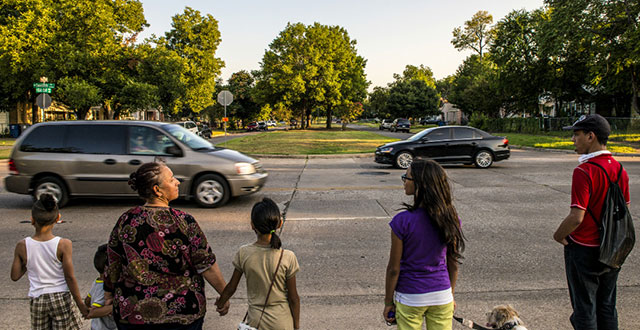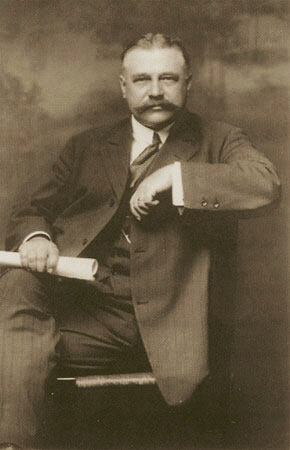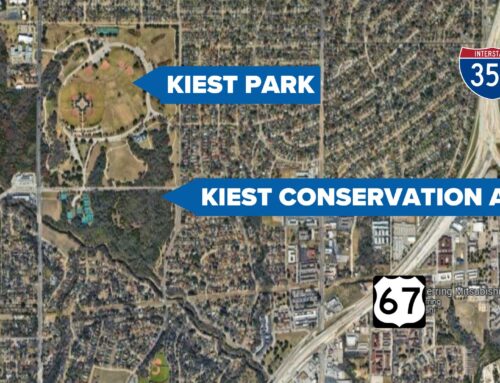
The wide medians on Oak Cliff Boulevard were part of George Kessler’s grand idea. Photo by Danny Fulgencio
Even when I was a child, some things simply didn’t make sense to me.
One of those things had to do with a local oddity that I began noticing early on, begging the question: What was the deal with the impressive — but highly out-of-place — wide, grassy medians in North Oak Cliff? Strangely disconnected medians. Abandoned medians. Medians that didn’t seem to fit their location at all. Even as a 5- or 6-year-old, I knew that something wasn’t right. But there they were, and there they stayed, and there they remain today.
Back in the 1950s, when my family traveled from our home by Kiest Park to the southwest corner of Wentworth and South Oak Cliff Boulevard to visit our family friends, the Smythes, we often traveled north on Edgefield, past Clarendon and then Burlington, which is where the mystery began. I always thought it strange that these potentially elegant medians lead to, well, nothing.
[quote align=”right” color=”#000000″]The “Kessler Plan” called for divided park boulevards landscaped with fountains, upscale shrubbery and trees, complete with recreational spaces. Designed primarily as paths for Sunday afternoon carriage rides and family leisure, these boulevards made sense in the first decades of the 1900s.[/quote]Like most children (and probably most adults), it seemed that a median like the one on Burlington would indicate something more akin to a highly charmed street scene from a movie such as “Pollyanna” or “Mary Poppins.” Or perhaps “Meet Me in St. Louis.” You know, some ritzy, turn-of-the-century Victorian neighborhood. But the smaller, frame and brick houses running along both sides of the street definitely weren’t the type of domiciles one would imagine lining a Victorian-era easement. At least not to me. But then I was a kid, and what did I know?
The several medians on South Oak Cliff Boulevard and the one that ran between Tenth and West Jefferson also seemed completely out of place. The medians up and down Jefferson made sense. But what was the deal with the others? I’d pondered these questions since roughly 1952.
Recently I stumbled on some information that answered my question. Actually, it was fairly simple.

George Kessler: Photo provided by stevenspark.org
When the City of Dallas contracted famed Kansas City landscape architect George Kessler back to Dallas (where he had grown up) to create a master layout, the design called for four boulevard loops around the city, one circling the area then comprising Oak Cliff and possibly part of West Dallas. The “Kessler Plan” called for divided park boulevards landscaped with fountains, upscale shrubbery and trees, complete with recreational spaces. Designed primarily as paths for Sunday afternoon carriage rides and family leisure, these boulevards made sense in the first decades of the 1900s. What could be more picturesque than affluent and semi-affluent Oak Cliff families hitching the family steed to a cute little surrey and impressing the neighbors by parading around the loop, or up and down one of the boulevards, with parents and cherub-faced children playing on the grassy, park-like medians?
The original 1911 design began at the viaduct and proceeded up Zang to Bishop (the street layouts were a bit different at the time), to Ballard and then Montclair, to Tenth up to Oak Cliff Boulevard, to Burlington, next to either Beckley or Marsalis and then back to the viaduct.
There was, however, one small problem that contributed heavily to ending Kessler’s impressive project: the automobile.
About the time construction began on the “loop,” the car — the most popular offspring of the internal combustion engine — exploded onto the American scene, causing the horse-and-buggy days to fade almost overnight. Although the automobile had been invented and developed during Kessler’s lifetime, speeds above 15 mph were unimaginable in his day. Thus the automobile and its increasing ability to reach higher and higher speeds were the death knell of Kessler’s fairy-tale vision. Sunday drives out in the country, with mom, dad and all the kids packed into the family car, quickly trumped those outdated and boring leisurely rides inside town.
Kessler understood the importance of protecting property value and used the proposed boulevard medians to encourage the construction of larger, more stately homes along the streets involved. But when the city realized that the project was no longer relevant to the evident transportation changes of the early 20th century, the project was halted and the plan eventually scrubbed. Although there are some larger homes lining Tenth, and a handful or so sprinkled along South Oak Cliff Boulevard, few of the envisioned larger homes were ever built, and only remnants of the boulevard loop project remain today.
[quote align=”left” color=”#000000″]Although the automobile had been invented and developed during Kessler’s lifetime, speeds above 15 mph were unimaginable in his day. Thus the automobile and its increasing ability to reach higher and higher speeds were the death knell of Kessler’s fairy-tale vision. [/quote]Yes, my question concerning the oddity of the medians was finally solved. But it took some additional mental calisthenics to figure out why the various boulevard sections were so disconnected, orphaned one might say. And why did the eastern end of the Burlington median simply stop, functioning as a would-be majestic entrance to nowhere. Shouldn’t there be some sort of 4- or 5-story mansion at the end? Perhaps the house in TV’s “Dynasty”?
Just as our modern highway and street construction goes, the planned Kessler loop was most probably developed in sections to eventually connect as the project progressed. When complete, the wide, grassy easements would link and become the elegant, winding pathway through Oak Cliff that Kessler and the city fathers of that day had imagined.
Obviously, that didn’t happen.
A beautiful landscaped loop through Oak Cliff would have been nice and would be nice now. But knowing my own high school friends and acquaintances (and also my parents’ Sunset and Adamson friends), the Kessler Loop would most likely have ended up being one of our teen “cruising strips,” along with South Hampton, South Westmoreland and the Kiest Park circle (which was, ironically, originally a bridle path).
And we definitely would have been driving faster than 15 mph. Yes, definitely.





